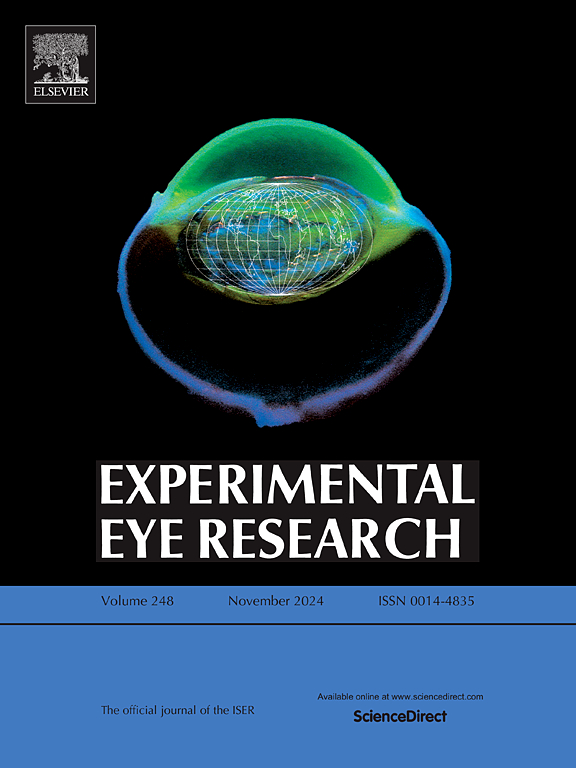The m6A transferase METTL3 regulates high glucose-induced proliferation and apoptosis of human lens epithelial cells through the lncRNA TUG1/KHSRP/p38MAPK signaling axis
IF 2.7
2区 医学
Q1 OPHTHALMOLOGY
引用次数: 0
Abstract
Diabetic cataract (DC) is one of the ocular complications in diabetic patients. This study aimed to investigate the mechanism of Methyltransferase-like 3 (METTL3)/Long non-coding RNA taurine-upregulated gene 1 (lncRNA TUG1)/KH-type splicing regulatory protein (KHSRP)/p38 mitogen-activated protein kinase (p38MAPK) signaling axis in DC progression. The expression of METTL3, TUG1, KHSRP, p38, and apoptosis-related proteins in tissues and cells were detected by RT-qPCR or Western blot. The m6A level was quantified using m6A colorimetric assay. RNA immunoprecipitation (RIP) assay verified the binding between RNA and protein. Proliferation and apoptosis of human lens epithelial cells (HLECs) were analyzed by CCK8 assay and flow cytometry. High glucose (HG) increased METTL3-mediated m6A methylation, which increased TUG1 expression. Knockdown of TUG1 increased HG-induced cell proliferation and decreased apoptosis. Knockdown of TUG1 decreased KHSRP expression, and RIP assays showed that TUG1 bound to KHSRP. Knockdown of KHSRP reversed the decrease in cell proliferation and increase in apoptosis caused by TUG1 expression. KHSRP affects the phosphorylation level of p38 and regulates cell proliferation and apoptosis through the p38MAPK pathway. This suggests that the m6A transferase METTL3 regulates DC proliferation and apoptosis through the lncRNA TUG1/KHSRP/p38MAPK signaling axis, providing a novel target for the treatment of DC.

m6A转移酶METTL3通过lncRNA TUG1/KHSRP/p38MAPK信号轴调控高糖诱导的人晶状体上皮细胞增殖和凋亡
糖尿病性白内障是糖尿病患者常见的眼部并发症之一。本研究旨在探讨甲基转移酶样3 (METTL3)/长链非编码RNA牛尿蛋白上调基因1 (lncRNA TUG1)/ kh型剪接调节蛋白(KHSRP)/p38丝裂原活化蛋白激酶(p38MAPK)信号轴在DC进展中的作用机制。采用RT-qPCR或Western blot检测组织和细胞中METTL3、TUG1、KHSRP、p38及凋亡相关蛋白的表达。用m6A比色法测定m6A水平。RNA免疫沉淀(RIP)实验证实了RNA与蛋白的结合。采用CCK8和流式细胞术分析人晶状体上皮细胞(HLECs)的增殖和凋亡情况。高糖(HG)增加mettl3介导的m6A甲基化,从而增加TUG1的表达。敲低TUG1可增加hg诱导的细胞增殖,减少细胞凋亡。敲低TUG1可降低KHSRP的表达,RIP实验显示TUG1与KHSRP结合。下调KHSRP可逆转TUG1表达引起的细胞增殖减少和细胞凋亡增加。KHSRP通过p38MAPK通路影响p38磷酸化水平,调控细胞增殖和凋亡。这表明m6A转移酶METTL3通过lncRNA TUG1/KHSRP/p38MAPK信号轴调控DC的增殖和凋亡,为DC的治疗提供了新的靶点。
本文章由计算机程序翻译,如有差异,请以英文原文为准。
求助全文
约1分钟内获得全文
求助全文
来源期刊

Experimental eye research
医学-眼科学
CiteScore
6.80
自引率
5.90%
发文量
323
审稿时长
66 days
期刊介绍:
The primary goal of Experimental Eye Research is to publish original research papers on all aspects of experimental biology of the eye and ocular tissues that seek to define the mechanisms of normal function and/or disease. Studies of ocular tissues that encompass the disciplines of cell biology, developmental biology, genetics, molecular biology, physiology, biochemistry, biophysics, immunology or microbiology are most welcomed. Manuscripts that are purely clinical or in a surgical area of ophthalmology are not appropriate for submission to Experimental Eye Research and if received will be returned without review.
 求助内容:
求助内容: 应助结果提醒方式:
应助结果提醒方式:


